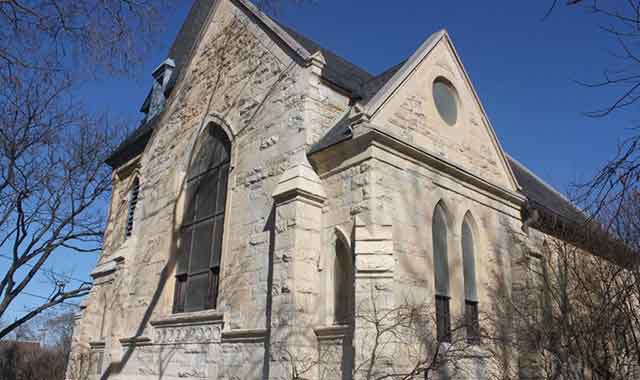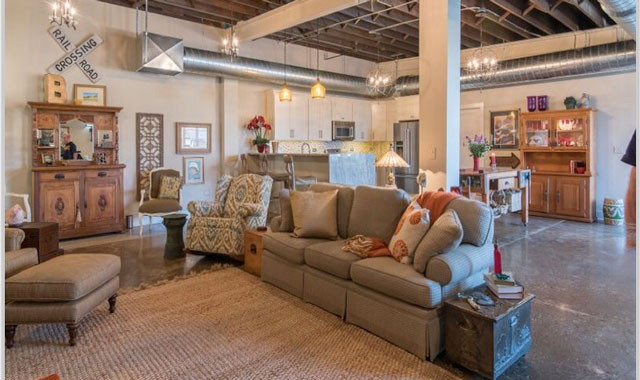Organized religion played a major role in the settling of Illinois and continues to influence the culture of our region. We highlight two places of worship, one in the country and one in the city.
“I love the recklessness of faith. First you leap, and then you grow wings.”
–William Sloan Coffin, Jr.

Country Church: Grace Lutheran Church • Est. 1907
1300 Kishwaukee Valley Road, Woodstock, (815) 338-0554, gracewoodstock.org
In 1907, members of St. John’s German Lutheran Church in Union formed their own congregation. Reasons included church restrictions regarding secular lodge membership, exclusion from an insurance program, and resistance to conducting services in both English and German.
After it was determined that the community could support another congregation, the group held its first service on March 17, 1907, in the rented German Presbyterian Church on Washington Street. The charter officially forming Grace Evangelical Lutheran Church was signed that June of that year, and the newly ordained Rev. Henry Behrens became pastor of the 115-member congregation.
A year later, he was replaced by The Rev. Roger Kaufman, who would serve for the next 44 years; his first act was to purchase the rented building for $2,000. Electric lights were installed, and a basement dug so that the church could be heated. A Moller organ was purchased in 1924, thanks to the Ladies’ Aid Society.
In 1953, the church was given a new front facade and tower, a west wing and a new basement with two new kitchens. In 1960, an educational wing and foyer were built. Missionary churches were established in Richmond in 1939, and in Wonder Lake in 1952.
By 1979, the combination of a growing congregation and declining condition of the building resulted in the purchase of property on Kishwaukee Valley Road. Ground was broken in 1983, and the new Grace Lutheran Church was dedicated in 1984.
Today, The Rev. Kenneth Gibson leads a confirmed membership of more than 1,700. On Saturday, a casual service is held at 5 p.m. On Sunday, a traditional service is offered at 8:30 a.m. and a contemporary one at 10:45 a.m. (10 a.m. in summer).

City Church: Calvary Episcopal Church • Est. 1855
222 S. Batavia Ave., Batavia, (630) 879-3378, calvaryepiscopalbatavia.com
In 1842, just nine years after the first settlers came to Batavia, Bishop Philander Chase, Illinois’ first Episcopal bishop, led services for the new Batavia Mission in the home of a member. In May 1855, the mission was officially recognized as Calvary Episcopal Church.
Its members constructed their first building, a wooden structure, on donated land at what is now the corner of Houston and Washington streets in 1856. The building was destroyed by a windstorm shortly after. The parish couldn’t afford to rebuild, so the property reverted to the donor, and its members went without a worship space, holding services sporadically at various locations.
By 1878, membership had reached 68, when John Van Nortwick and his wife donated the land and paid for construction of the present church. The cornerstone was laid in September 1879 and dedicated in 1881. The couple later donated as a rectory the large house at Batavia and Union streets, which still stands.
Repairs were made during the early 1900s, but materials became scarce during WWI. A new parish hall was constructed in 1923, partially funded by a bond issue that designated it as a community center. Over the years, the parish hall has hosted club meetings, civic organizations, plays and recitals, and served as a polling place. A new organ and a new rectory were purchased in 1924. In 1940, a complete renovation of the interior removed old plaster and tin and opened the ceiling to expose the beams; new light fixtures, choir rail, pulpit, sanctuary and more were installed.
Classrooms for a growing Sunday School were added in 1949, and a larger educational unit was built in 1969. For the building’s 100th anniversary in 1981, the interior was once again given an update and renovation. In 2009, major structural faults in the structure of the church required extensive repair and restoration of the roof, original masonry and Batavia limestone.
Today’s congregation is led by The Rev. Michael D. Rasicci, with worship services held Sunday at 6 and 10:15 a.m., Tuesday at 7 a.m., Wednesday at 9:30 a.m., and Thursday at 5:45 p.m.




















































